#south american weevil
Text
Lady Granville’s beetle parure and case, 1884–85.

Lady Granville’s beetle parure and case. Photograph: British Museum, London.
The Victorian obsession with colour led to some disturbing embellishment of natural wonders. This tiara, from the British Museum’s collection, contains the iridescent bodies of 46 South American weevils, gifted by the Portuguese ambassador to the British foreign secretary, Lord Granville.
#insects#beetles#jewelry#victorian#parure#british museum#london#tiara#south american weevil#lord granville#lady granville#insect jewelry#19th century
2 notes
·
View notes
Link
Protect your plant or tree getting damaged from South American Palm Weevil. Connect with us to get effective palm tree treatment in San Diego.
1 note
·
View note
Text
We leverage the natural experiment generated by the boll weevil infestation from 1892-1922, which disrupted cotton production in the region. Panel difference-in-differences results provide evidence that Southern society became less violent and repressive in response to this shock with fewer lynchings and less Confederate monument construction. Cross-sectional results leveraging spatial variation in the infestation and historical cotton specialization show that affected counties had less KKK activity, higher non-white voter registration, and were less likely to experience contentious politics in the form of protests during the 1960s. To assess mechanisms, we show that the reductions in coercion were responses to African American out-migration. Even in a context of antidemocratic institutions, ordinary people can retain political power through the ability to ``vote with their feet.''
The nber manages to put a surprisingly positive spin on black sharecroppers being driven out of the south by weevil infestations to the point that racist terrorists no longer felt the need to throw their weight around
67 notes
·
View notes
Text
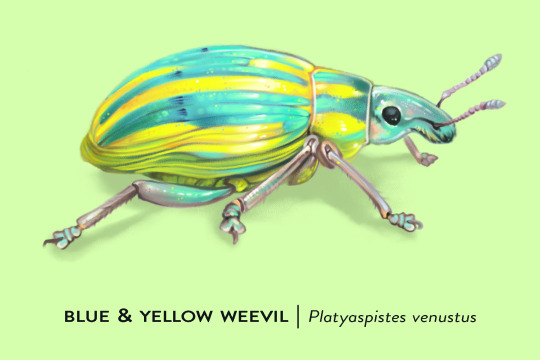
Platyaspistes venustus, also called the Blue and Yellow Broad-Nosed Weevil, kicks off Day 8 of the 30 Days of Weevils art challenge!
Like other broad-nosed weevils, this weevil is characterized by a scar on the tip of its rostrum, left over from mandibular processes that fall off in its adult life. Vibrant colors stripe its elytra, making it a beautiful sight in its native South American environment!
Reference image found here!
#30daysofweevils#30 days of weevils#weevils#broad nosed weevil#entomology#bugblr#insects#digital art#Curculionidae
83 notes
·
View notes
Text
What does "potato bug" mean? (Survey results)
The results are in for my survey looking at possible regional differences in how the term “potato bug” is used, and, as I hoped, there were some interesting regional patterns!
In total there were 420 responses, and major results are summarized below the cut (note: there are also a bunch of photos of bugs, just be aware). I’ll also add more specific/minor results in a reblog (linked here) ~
A “potato bug” according to Americans* and Canadians (*except Californians):
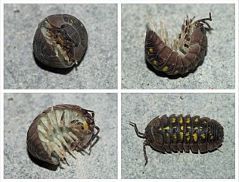
A majority of Canadian respondents (14/19, or ~74%) as well as a plurality of American respondents (128/362, or ~35%) indicated that “potato bugs” are the tiny isopods that curl into a ball (also known as “roly polies,” “pill bugs,” and many, many other regional names)
Notably, the usage of “potato bug” to refer to the roly poly appears to be geographically widespread within the United States, with the roly poly being selected by at least 20% of respondents from all US subregions except for the South Central parts of the country (around Texas).
Curiously, Wikipedia lists the UK as being a region where “potato bug” can refer to these kinds of woodlice, but not a single UK respondent selected the roly poly, and only a small minority—2/15—indicated that they had ever even heard the term at all.
A “potato bug” according to Californians:

Californians were unusual among Americans in that a majority of Californian respondents, 29/46 (63%), indicated that the term “potato bug” refers to the cricket-like members of the tribe Stenopelmatini, more commonly known as the “Jerusalem cricket” (although, as I have explored here before, these critters also have many delightful alternative names). This usage is notably uncommon elsewhere in the country, with only 25/316—8%—of non-Californian US respondents selecting the Jerusalem cricket as the “potato bug.”
A “potato bug” according to Europeans** (**kinda…sorta…):
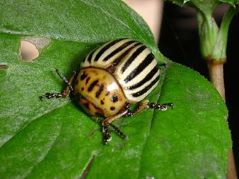
A majority of non-North American respondents indicated that they had never heard of a “potato bug” before, 23/39 (59%). However, among the subset of Europeans who had heard of potato bugs, an overwhelming majority selected the Colorado potato beetle as the “potato bug,” 12/14 (86%). Notably, although these bugs are endemic to the central US, they have spread to Europe as an agricultural pest, which may partially explain this pattern (although as a caveat, the sample size for non-North American respondents was quite small and so this result should be taken with a big grain of salt!).
American respondents occasionally selected this bug, too, although it was not an especially common choice, with 49/362 (14%) of Americans selecting the Colorado potato beetle and no US subregions showing even a 1/3 selection rate for it.
Other potato bugs?
25 respondents indicated that the term potato bug referred to a type of bug that wasn’t included in the survey, with the comments suggesting other potential “potato bugs” might include potato weevils, June bugs, spined soldier bugs, boxelder bugs, and ladybugs. There were also a couple of general descriptions of bugs that I couldn’t quite match to anything specific.
Most of these other potential “potato bug”-types were only mentioned once, although the most common among them—the June bug—was described by 5 different respondents.
Overall Numbers
Overall, 289/420 (~69%) of respondents had heard of “potato bugs” before, with the term appearing to be predominantly a North American expression: 273/381 (72%) of North American respondents were familiar with the term, compared to 16/40 (40%) of non-North American respondents.
Here’s the response totals for how often each “potato bug” type was selected:

~
Alright, that’s all for now—maps/data tables coming in a reblog available here. :)
#Bugs#Insects#Potato bug map#Potato bugs#Potato bug#Survey results#Surveys#Graphs#Graph#Dialect Maps#Linguistics#Slang#Roly poly#woodlouse#Pill bug#Jerusalem cricket#Child of the Earth#jailbug#Colorado potato beetle#Potato beetle#sC original#someday I will learn how to be succinct when writing these. someday.
19 notes
·
View notes
Note
Revretch I am back with more made up bio questions, what would it take to make a beetle (true beetle!) to be like, a MASSIVE threat of an invasive species across all environments but its own native island? Basically I have this beetle that eats a lot, but on its own island this isn't an issue because the grubs are eaten up when they're still in the ground and population is kept low. I wanna know how I could make this the most fucked up invasive beetle possible because it's extremely useful for medicine which has created a black market for it, and I think as dungeon master I can have my players do a lil environment mission, as a treat for me
Well, it's not just a matter of how much it eats, it's a matter of what it eats. Any important crop--or several--being targeted by a particularly prolific beetle spells trouble.

The khapra beetle is one of the 100 worst invasive species in the world. It infests all kinds of grains, cereals, rice, dried beans, seeds, etc. etc. It can survive long periods without food or water, and is resistant to many insecticides. It can also cause horrible allergic reactions.
It's also a matter of how prepared the people in those environments are for it.
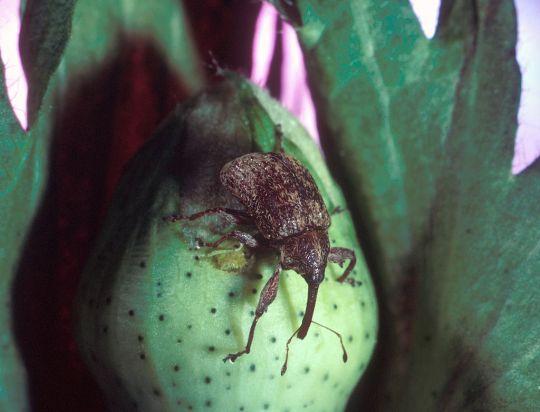
Before pesticides, boll weevils were a tremendous problem (and still are, though to a lesser degree). The effects of their devastation of cotton crops decimated much of the American South's economy and substantially altered American history. Even now, according to Wikipedia, 90% of Brazilian cotton crops are infested by them.
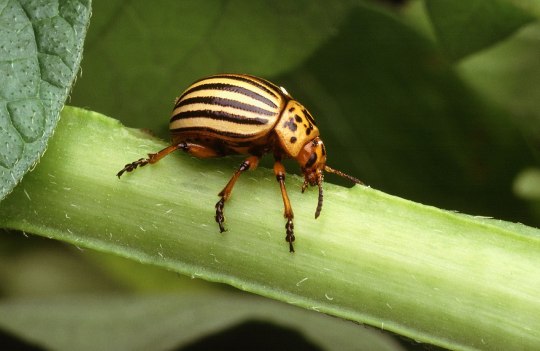
There's also the Colorado potato beetle. After WWII, nearly half of all potato fields in East Germany were infested by it. Again, pesticides helped. (Though, of course, at a horrifying environmental cost, but that's another discussion.)
So, really, you just need to figure out which crops are the lynchpins of your setting's societies, and have the beetle pull that out from under them. Being as invulnerable as the khapra beetle is a bonus. For extra tenacity, you could even make its diet as diverse as the mealworm's--they can get by on styrofoam.
28 notes
·
View notes
Text
Well I'd best explain myself.
Hey. It's milk ✌️
If you know me from being moots elsewhere.. Hi! This is my special interest blog. A real rebloggy blog. For reblogging. And talking about my interests if I feel like it!
Current interests:
In no particular order
- Figures ✨
I collect figures. I have like well over 300 at this point. I don't keep track anymore and this one is slowly but surely subsiding. I will always adore figures and collecting them though. My figures make my room a safe place for my senses. They're all so pretty 💖
- Pokémon 🌈
Oh my god an autistic person who likes Pokémon it's a miracle. Yeah. I started playing Pokémon when I was 3, so 17 years going strong. I originally preferred the toys and cards, but heart gold and soul silver converted me and then I became a mega fan. Tracking releases, learning lore, creating fanart. Mind you I was like 7. There's a deviantart account out there from when I was 6? and yeah that shit Sure Is (you can try and find it I don't really care anymore jfjsjfjg). Anyway!!! Faves are cleffa, whimsicott, blaziken, galvantula, giratina, mimikyu and Registeel. Faves by proxy include lapras, torkoal, lilligant, gengar, rayquaza, mudkip and ledyba. Fave humans are Iono, Lillie (LillieMoon 💖💖💖), Ingo and Emmet, allister, N, Erika and Elesa. Gen 5 is currently my favourite but I have played gen 5 a LOT the past few years and a lot of my faves are gen 5. I attended both the Pokémon center pop up in London in 2018, and EUIC 2024 in London, also for the Pokémon center lmao.
- Bugs 🐛
Woo big surprise it/they user enjoys bugs. My favourites are moths, exact favourites being hummingbird hawk moths and Madagascan sunset moths. Also a huge fan of weevils, worms, snails, beetles, bees and butterflies! I hope to have a butterfly collection one day in frames :3
Hatsune Miku.
- One piece ☠️
Pretty new one but yeah, I'm caught up so I spend a LOT of time thinking about them damn pirates. Faves in no order are Zoro, Luffy, Usopp, Sanji, Robin, Perona, Mihawk, Law, Corazon, Ace, Yamato, Katakuri, Crocodile, Buggy, Doflamingo, Lucci, Okiku, and Big Mom.
- No but for reals Miku 🎧
Fun fact! I've been a Miku fan since 2010. That's 14 years baby!! My first vocaloid songs that I remember hearing are nyan cat (duh), world is mine, Romeo and Cinderella, butterfly on your right shoulder, gugurekasu, and my all time fave, corruption garden. Absolutely underrated banger. This should be a general vocaloid section really because my favourite cryptonloids are Kaito, Luka and Miku and then my favourite non cryptonloids are Meika Mikoto, Lily, Nekomura Iroha, PoUta, Teto and Luo Tianyi! My favourite producers are PinocchioP, Neru, Giga, Kira, Iroha(sasuki) and OwataP!
I went to Miku expo in London 2018, 2020 and I am going in 2024!!! A selection from my personal wishlist for London 2024 setlist :
Paradichlorobenzene - OwataP 💛
Kokoro - Toraboruta 🧡
Kunoichi Demo Koi ga Shitai - MikitoP 🩵🧡
Digital Girl - Kira 🩵
Break it, Break it! - E.L.V.N ❤️
Non Breath Oblige - PinnochioP 🩵
Erase or Zero - crystalP 💛💙
-Minecraft 🌲
Yeah yeah you can laugh all you want. I've been consuming Minecraft since it came out, and I've played it for 10 whole years. I got pc edition 5 years ago now (INSANE). I love Minecraft. I tend to play just random mods shoved in a folder, but I do play with friends sometimes!!! If anyone ever wants to play please tell me I will kiss you.
NON SPECIAL INTERESTS BUT VERY IMPORTANT TO MY IDENTITY
-Dinosaurs (since I was like 4)
-Sanrio (as long as I can remember)
-Animals
-Anime in general
-Art (lotta A's huh)
-Shitty adult cartoons (south park, family guy, American dad, I have encyclopedic knowledge of all 3 and I can recall every episode. I also know family guy season 4 word for word :3)
-Sitcoms (Actually enjoy: Two and a half men, modern family, young Sheldon kinda, does house count? It should. Encyclopedic knowledge: Big Bang Theory, Two and a half men, Frasier, Friends)
THE "SOMETIMES" SPECIAL INTEREST
- Five Nights at Freddys 🐻
I know, I'm so cool. This game has had its dirty grip on me since it came out. Basically I hate it but every time a new game comes out I can't help but go on a self destructive info absorb and I watch like 6 hour video essays on the new lore and implications. It's fun I like fnaf silly Creachure. My fave is the puppet because I'm non binary haha.
-UNDERTALE ❤️
I pretty much tick all the boxes for middle school anxiety huh. Yeah undertale is a beautiful masterpiece and every few years I'll have a mega "aaaaa undertale" phase where I'll just do nothing but play and consume undertale content. I've played the game through at least like 10 times? A few of each ending. I'm still really bad at sans fight.
-Animal Crossing 🐾
I think everyone should have this one. Occasionally I'll just be like "hm being an adult in the real world isn't really what I wanted right now" so I play animal crossing until oops 6 hours passed. I'll then play for about a week before putting it down again. I tend to stick with new horizons, just because it has the best gameplay. Also BUGS heheshhfksjgh. Fave villagers are Lily, Eugene, Beardo, Judy, Merengue, Lolly, Merry and Marina. I also love Flick and Celeste.
Kinning!!
Yeahhh I kin some bitches. Big deal.
- Yamada Ryo
The big one. She's just me for real for real. I love her for realsies. Also um hi bocchi kinnies.
- Rina Tennoji
She's so fucking autistic. I also struggle with expression (fluctuates between under and over!).
- Kokoro Tsurumaki
Genki. I have made it my personal goal to make people happy in recent years and it's really helped my own mental health
- Madoka Kaname
😳🩷🖤
- Kirby
Small, Round, Pink, Poyo
- Flandre Scarlet
Tiny Creachure clinging to childhood (with a dash of trauma).
- Kanna Kamui
I just, deep down. I experience friendship the exact way Kanna does. I have no concept of boundaries. I will crawl into your bed at night.
- Stocking
Sweets, hypersexual, kinky, goth, chubby. Me.
- Yamato
Oblivious, love friend so much, bad family relationships.
- Kuromi
*cough cough* *straightens paper* Although Kuromi may look and act tough and punk, she is actually very girly and is attracted to good-looking guys. That is all.
And yeah I think that's pretty much it. Obviously this post will get updated as regularly as it needs it. Hope u enjoy my silly content!!!
#figures#death#bugs#pokemon#hatsune miku#one piece#Minecraft#Dinosaurs#Sanrio#Milkytalk#updated 28/4/2024
4 notes
·
View notes
Text

Date Palms
The end of a species, like the
Elm.
photographer Jon Pinter
(The South American weevil is killing these great trees)
#tree#trees#sandiego#socal#nature#naturephotography#photographyisanart#PhotoOfTheDay#PicOfTheDay#ImageOfTheDay#Photography#Coastal#fotografie#fotografia#coastlife#westcoast#california#olympus#foto#photo#ColorPhotography#digitalphotography#ColorPhotograph
2 notes
·
View notes
Note
Have u heard the dead south’s new ep’s? The bluegrass one is. I never thought I’d describe anything by them as beautiful but holy cow their version of ‘will the circle be unbroken’ is straight up gorgeous, one of the prettiest songs I’ve heard in a hot minute. Also props to them for making ‘keep on the sunny side’ and ‘you are my sunshine’ *deeply* unsettling
AHHHHHHHHHHHH YOU SENT ME THIS IN APRIL AND I AM ONLY RESPONDING NOW. I'm so so so so so sorry! I hope you see this!
I keep intending to listen to the latest material from The Dead South. That's why I hadn't answered - I wanted to listen first. But I'm responding now to 1). let you know I've been thinking about you this whole time, and hopefully, 2). to get my buttocks on that listening.
I think I've listened to part of Will the Circle Be Unbroken. When I first learned they did that song, I was intrigued. It was as unexpected to me as when they did This Little Light of Mine. It's not in their usual "degenerate" repertoire.
But I'm going to opine even though I haven't listened yet. The Dead South taking a long-standing country standard is appropriate.
A band with a new sound and take on North American string band music is harking back to its history. It's like it's an intentional demonstration and message of old and new. Music will always be changing, always be growing, and it should be growing (just as, I remember, their Will the Circle Be Unbroken was unique), but it comes from a stream of what came before.
In a ways, it makes me think about the bluegrass community's reception to The Dead South. The band wrote Blue Trash in response to bluegrass purists disliking "impure" bands like them - traditional bluegrass is fine, the song suggests, but why revolt against the new?
"We love bluegrass. The reason that this band was started was bluegrass. And here’s what we do with bluegrass: we take our parts of it. Colton on the banjo, he’s playing better than half the folks you hear on Bluegrass Junction, and [it’s] fantastic that we can have those elements, but we’re not claiming to be the best, or to be stealing it. We’re just trying to be a part of the community and play music."
So there are purists who don't like "impure" bands. But at the same time, mobs of bluegrassers worship the ground of Billy Strings, who's hardly "pure" in my book. I've heard someone else talk about what makes Billy Strings great: it's not the material he selects, but what he does with the material. And I don't listen to Billy Strings, but there's something to be said that he can take bluegrass standards and transform them into something wholly different. Same can be said of the Punch Brothers - what they did with Boll Weevil!! The Dead South historically has leaned into their own repertoire of gunslinging, alcohol-drinking sinners, but I like that they, too, have made a choice to engage with standards and, I suspect, transform them, too.
Playing those standards? That’s them participating in the community, eh? And transforming a song with a bright message into something unsettling sounds like an interesting part of “not the material you select, but what you do with the material.”
So I'm all for them leaning into Carter family songs like Keep on the Sunny Side. Even if I haven't listened yet, I approve the repertoire choice.
#beastoftheblackhole#thatbanjobusiness#that banjo business#long post#The Dead South#music#General Banjo Business#ask#ask me
2 notes
·
View notes
Text
babe wake up they glued weevils to sticks for science
South American palm weevil
og video by Deep Look, "A Real Alien Invasion Is Coming to a Palm Tree Near You"
1 note
·
View note
Text
I’M BACK
WF THOUGHTS (3/27/23).
I’ve been on “special assignment” in North Carolina. I hope you didn’t miss me too much.
During my hiatus, I read a book written by a guy who biked across America. The book was about his trip, and how it helped him come to grips with some personal demons. It took the guy 294 pages to tell his story.
The book taught me a new word: “honyock.” (Pronounced: hon-yock.) It’s a derogatory term used to describe an oaf or rube. Originally, the word was apparently used to describe peasant immigrants from central or eastern Europe. The biker heard about honyocks when he was biking through New Mexico. I like new words. I’m going to add honyock to my vocabulary.
I always thought there was a rat-like animal called a bow weevil. I don’t know how or when I heard about this animal. Well, it turns out that I was mistaken. The animal is a “boll weevil.” It’s not rat-like. It’s a small beetle that’s smaller than your smallest fingernail. From the 1920s until the 1980s, when the widespread application of insecticides solved the problem, boll weevils decimated the cotton crop in the American south. The biker learned all about this plague as he biked through Arkansas and Mississippi. I’m glad that I’ve been educated on this issue.
The biker seemed to have a great time in Mississippi. He stopped at a tiny convenience store, and the shopkeeper asked where he was going. The biker explained his full trip, and said that his final destination was Tybee Island off the coast of Georgia. The shopkeeper replied: “Gaw-uh-ud day-umm.” It took the biker a minute to “translate” that response into English. The biker asked about the best route to get out of town. The shopkeeper explained that the main road would be full of big trucks and that the “backroad” would be full of nasty dogs. He left the choice to the biker: “Which do you choose, Mr. Biker? Death by truck or death by dog?” The biker took his chances with the trucks, and he survived.
Also in Mississippi, the biker was brave enough to try the shower facilities at a truck stop. I’ve always wanted to do that. The biker said that he had a wonderful experience, in a spotless shower, for $10. When he returned his towel, they gave him back $5 for the “towel deposit.” I think we should all try a truck stop shower sometime during 2023.
The biker is a wealthy white guy. On the ride, he thought about his life. He had deep, philosophical, thoughts. He recalled a book that he had read called “Affluenza: The All-Consuming Epidemic.” The authors defined the illness of “affluenza” as “a painful, contagious, socially transmitted condition of overload, debt, anxiety, and waste resulting from the dogged pursuit of more.” The biker noted that America has twice as many malls as high schools. He also noted that many homes now have garages that are bigger than a typical 1950s home. Our cars have become “living rooms on wheels.” He concluded that “our priorities are fouled up,”and he resolved to elevate his personal happiness by leading a life of simplicity and frugality. There’s a message there for all of us. Physical “stuff” is not important.
The biker crossed America, from west to east, without ever getting a flat in his front tire. He experienced numerous flats in his back tire. Two years after his long ride, the biker decided that he should also cross America from south to north. Before he left, he thought about changing his front tire. He decided that the original tire was a “good luck charm” and that he should stick with it. So, with the same front tire, he biked from the Mexican border to the Canadian border. Miraculously, he also competed that trip without a front tire flat. All in all, that tire covered more than 4,500 miles without a flat! I think the biker should hang that tire on a chain and wear it around his neck.
It’s good to be home. If you’re lucky, I’ll find some time to blog about some serious issues. Stay tuned.
0 notes
Text
Day 6 : 29th June 2022- Henrico VA
A full on day today, woke up with the lark and on the road to Appomattox Court House by 8.30am
You would be forgiven for thinking Appomattox Court House is a building , however it is the name of a small town in Virginia. Yes it does have a Court House ( therefore Appomattox Court House, Court House ! ), a small prison and had a sizeable community of about 100 during the Civil War era, including the enslaved, a ratio of 50/50 according to the Ranger who gave us our talk.
I’ve never heard of A C H, until today. It was here on April 8th 1865 that General Robert E Lee , Commanding General of the Confederate Army ( Southern States) surrendered to General Ulysses S Grant, General in Chief of Union forces (Northern States ).
Lee’s surrender signalled the end of the Southern States’ attempt to create a separate nation.
Within 3 days, the men of Lee’s army had turned over their flag, stacked their weapons and began the journey home.
That day was declared Freedom Day for the enslaved people of the South, Lincoln’s Emancipation Proclamation was put into force and thousands of black people had got their freedom, but not equality, however that’s another story.
Of course Appomattox wasn’t the end of the war, if only General Lee could’ve call up the other Southern armies on his mobile to let them know what was happening ? However it started a domino effect and one by one the rest of the Southern forces surrendered. Once the the guns stopped firing, the opposing sides could talk and an uneasy truce became the United States of America.
We then left for Pamplin Historical Park in Petersburg and the Museum of the Civil War Soldier. We always hear about Lee or Grant or Custer but never the the common soldier, our aim was to learn more about them.
We were treated to a living history enactment by a “ confederate soldier” and the frightening thing was that 2 in every 3 soldiers were killed not from gun shot wounds, but from disease.
Dysentery was rife, so was gangrene and scurvy. The common Confederate soldiers diet was anything but, salted pork months old, bread with weevils writhing out of it, no fruit or fresh water. No wonder the young men suffered so much with ill health.
The Union soldiers fared a bit better, but life must’ve been so hard for both sides, so that when peace eventually came, it came with relief for them all.
We are staying in Henrico, just outside of Richmond Virginia.
Legend has it that this area was were Pocahontas ( playful one ) lived, her given name was Matoaka and she was the daughter of Chief Powhatan.
Contrary to popular belief and Disney, Pocahontas did not marry John Smith, a ruthless privateer working for the East India Company, but a John Rolfe. She was baptised and given the name Rebecca after which she travelled to England to be presented ( shown off ) to Queen Vick, funnily enough she contracted a cold, the native Americans obviously had no immunity to this type of illness and poor little Matoaka died in Gravesend in 1617 and is buried there.
So tonight we went to Mission BBQ, which is about 10 minutes walk away, however it felt like an hour in the searing 90 degree evening heat. It was worth the walk because it was the best BBQ and now I’m stuffed sitting in our room, a cold glass of wine at my elbow, ready for a shower and an early night.
0 notes
Link
Is your Palm tree infested with SAPW ? Get rid of the South American Alpine Bed Bug with an effective treatment by our expert arborist at an affordable price.
0 notes
Text
How to Save your Tree from the Devastating South American Palm Weevil

One of South America's most destructive pests, the South American Palm Weevil, can wreak havoc on your prized palm tree. This beetle bores through the trunk of the tree, slowly killing it. If you suspect that your tree has been infested with South American Palm Weevils, you need a professional tree care or there are some things you can do to try to save it.
First, you should inspect your tree for signs of infestation. The beetles themselves are small and black, and they will leave telltale signs of their presence such as holes in the trunk and piles of sawdust around the base of the tree.
If you do find evidence of an infestation, there are a few things you can do to try to save your tree. One is to inject it with a pesticide. You can buy a kit to do this yourself, or you can hire a professional to do it for you. Another option is to wrap the trunk of the tree in a protective material such as tar paper or burlap. This will help to keep the beetles from boring into the tree.
If your tree is already heavily infested, and you have been unable to save it, it may be necessary to have it removed. Contact a professional arborist to schedule an appointment. They will be able to safely remove the tree and dispose of it properly.
So, if you suspect the infestation on the crown or see brown-drooping fronds, notched, clipped, and widowed leaflets, call professional palm weevil exterminators before they damage all palm species in your landscape irreversibly. Our tree doctors in San Diego inspect, diagnose, and stop the spread of palm weevils by using non-toxic and long-lasting treatment solutions. The intensity of palm weevil infestation is also checked, so we can offer optimum treatment.
#South American Palm Weevil San Diego#Bed Bug Treatment San Diego#Bed Bug Removal San Diego#Bed Bug Pest Control San Diego#Bed Bug Exterminator San Diego
0 notes
Text

Day 6 of the 30 Days of Weevils art challenge features the broad-nosed weevil species Compsus viridivittatus!
This weevil is considered a Citrus pest across its native South American habitats. Its subfamily, Entiminae, is incredibly diverse with over 12,000 described weevil species - ranging in color, habitat, and morphology!
Reference image found here!
#30daysofweevils#30 days of weevils#weevils#compsus viridivittatus#insects#bugs#bugblr#entomology#nature#illustration#oughh im super behind on these guys due to my Silly Life (tm) HOWEVER i am determined to have a free day where i can catch up on them!! >:3
22 notes
·
View notes
Text
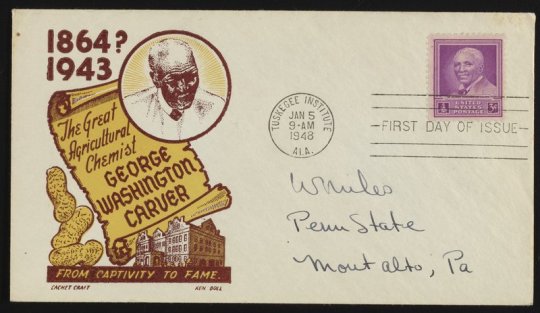
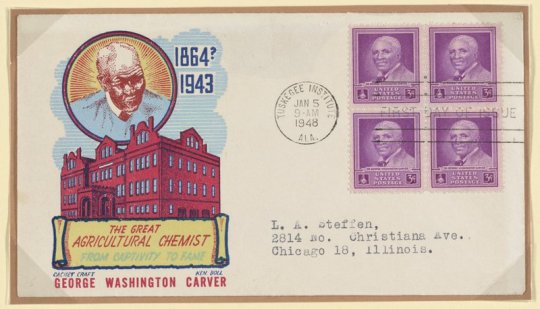

George Washington Carver (c.1864-1943) was an American agricultural scientist and inventor who promoted alternative crops to cotton and methods to prevent soil depletion. He was the most prominent black scientist of the early 20th century.
Carver's early life is not well documented; he was careful about his image. He left behind snippets of his early life which he described as hard early years. He was born into slavery.
At the age of 11, Carver traveled to Neosho, Missouri where he attended a school for Black children. This was his first time in a predominately African American setting. There, he acquired a set of Black "parents," Mariah and Andrew Watkins. Mariah was an influence on Carver's life, she was a nurse and midwife with a wide knowledge of medicinal herbs.
He attended Simpson College, a small school in Iowa, studying grammar, arithmetic, voice, piano, and art. His art professor, Etta Budd, learned of Carver's interest in plants and herbs and suggested he study botany pushing him to enroll in Iowa State University. He made quite the impression on the faculty at Iowa State, who encouraged him to stay on as a graduate student. Carver obtained his Master of Agriculture degree in 1896. He joined the faculty at Tuskegee Institute in 1896.
George Washington Carver used his training as an agricultural chemist to help improve the lot of poor black and white Southern farmers. He taught farmers about fertilization and crop rotation and by developing hundreds of new products from common agricultural products. Late in Carver's life he worked in the chemurgy ("chem" from chemistry; urgy, Greek for work) movement. The term was used to describe scientists, agriculturalists, and industrialists who were determined to put chemistry to work to find nonfood uses for agricultural surpluses. One of the prime backers of chemurgy was Henry Ford, who Carver variously addressed in letters as "My beloved friend" and "The greatest of all my inspiring friends." Ford visited Tuskegee in 1938, and Carver was Ford's guest in 1940 at the automaker's Georgia estate.
Carver dedicated his entire scientific work to the goals later advocated by the chemurgy movement. Carver's laboratory at Tuskegee developed hundreds of new uses for agricultural products. The need for this resulted in part from Carver's initial success in increasing agricultural productivity on the cotton-depleted, tired, old soils of the South. On the ten-acre experimental station at Tuskegee Carver was able to increase dramatically soil productivity by using good cultivation practices and rotating soil-enriching plants like cowpeas and beans.
Carver showed that when he took land on which cotton had been planted, a crop which robs soil of nutrients, and planted nitrogen-fixing legumes, like peas and beans, he was able to increase yields significantly when the land reverted to cotton a few years later. Carver accomplished this without the use of commercial fertilizers, which was too expensive for poor farmers to use. Carver was aware that "every operation" he performed had to be within the reach of a "poor tenant farmer with a one-horse equipment."
Carver's success with planting legumes led to his encouraging Southern farmers to turn to these crops. This became even more urgent with the devastation in the early 20th century of the cotton crop due to the boll weevil. But if Southern farmers were to be convinced to grow crops other than cotton, there had to be a market for peas, sweet potatoes, soybeans, etc. This need pushed Carver into the laboratory to work on finding alternative uses for these products. From sweet potatoes, for example, came a raft of new products: flours, starches, sugar, a faux coconut, vinegar, synthetic ginger, chocolate and such non-foods as stains, dyes, paints, writing ink, etc.
It was the peanut that made Carver famous. The peanut attracted his attention because it is easy to cultivate, it enriches the soil, and it is a ready source of protein, an especially important consideration since poor black farmers could not afford meat. From the peanut Carver developed a host of new products: most notably milk, but also butter, meal, Worcestershire sauce, various punches, cooking oils, salad oil, milk and medicines as well as cosmetics such as hand lotions, face creams, and powder. All together, he discovered more than 300 food, industrial, and commercial products from the peanut. Carver's research on foodstuffs derived not only from his belief that he had to find new uses for agricultural products to encourage farmers to grow them, but also because he saw many of these new products as nutritious additions to the diet of poor southerners. Similarly, he experimented with paints that could be made from Alabama clay since he knew that poor farmers could not afford commercial applications.
Carver passed away 5 January 1943 in Tuskegee, Alabama at the age of 79 from complications resulting from a fall that left him unconscious. He was buried next to Booker T. Washington at Tuskegee University. Due to his frugality, Carver's life savings totaled $60,000 (approx. $989,830 in today's money) all of which he donated in his last years and at his death to the Carver Museum and to the George Washington Carver Foundation.
First image: Cachet Craft. “First Day Cover Honoring George Washington Carver.” United States, January 5, 1948. Box 1. Science History Institute. Philadelphia.
Second image: Cachet Craft. “First Day Cover Commemorating George Washington Carver.” United States, January 5, 1948. Witco Stamp Collection, Box 1. Science History Institute. Philadelphia.
Third image: Cachet Craft. “First Day Cover Honoring George Washington Carver.” United States, January 5, 1948. Box 1. Science History Institute. Philadelphia.
#george washington carver#peanuts#legumes#black history#black scientists#Black in STEM#history#history of science#tuskegee#agriculture#digital collections#stamps#chemists#chemistry#chemurgy#black chemists#black agriculturalists
76 notes
·
View notes